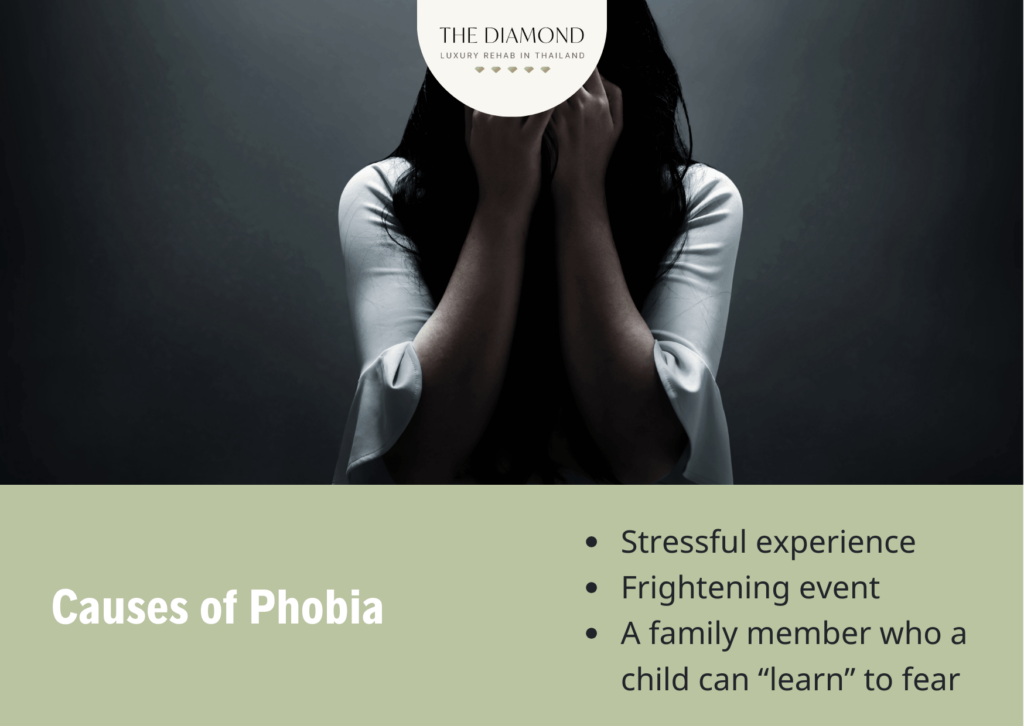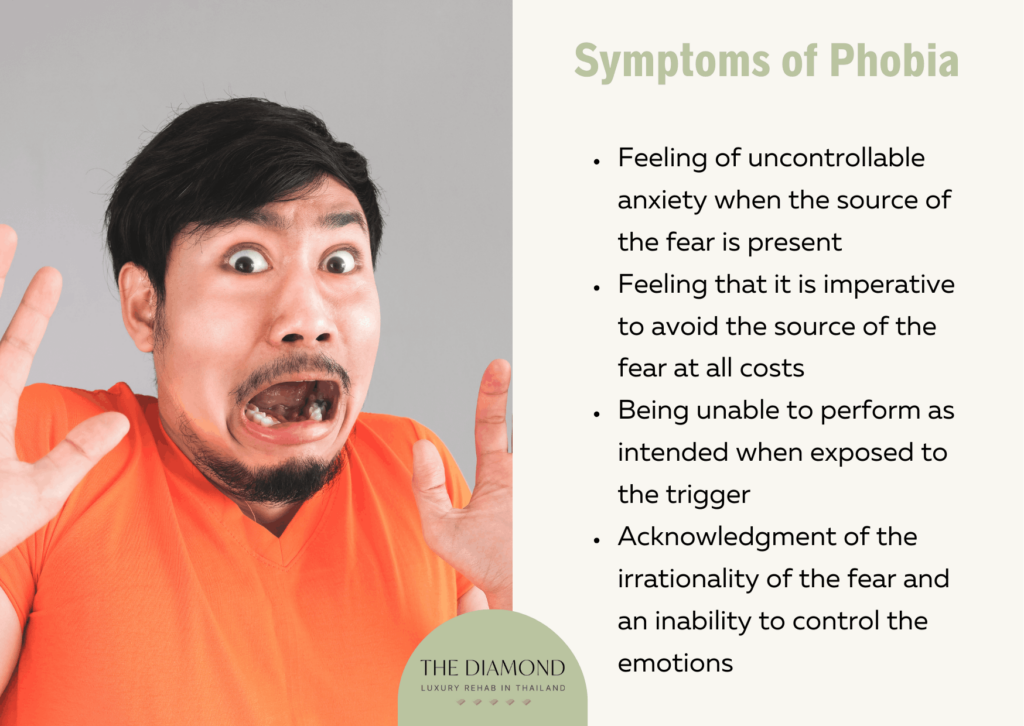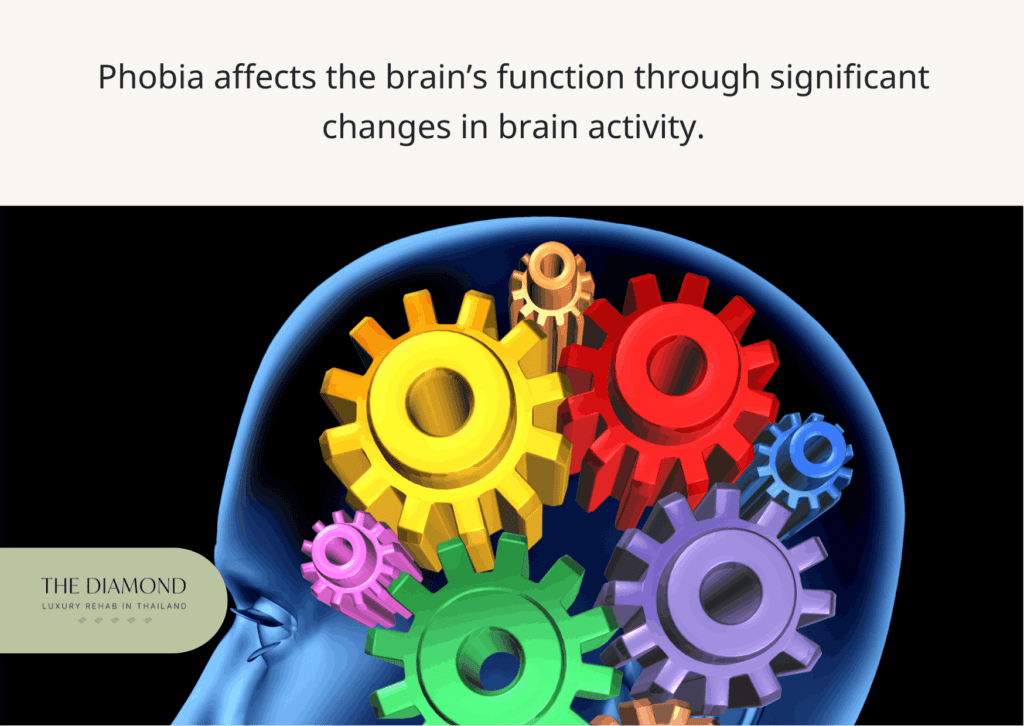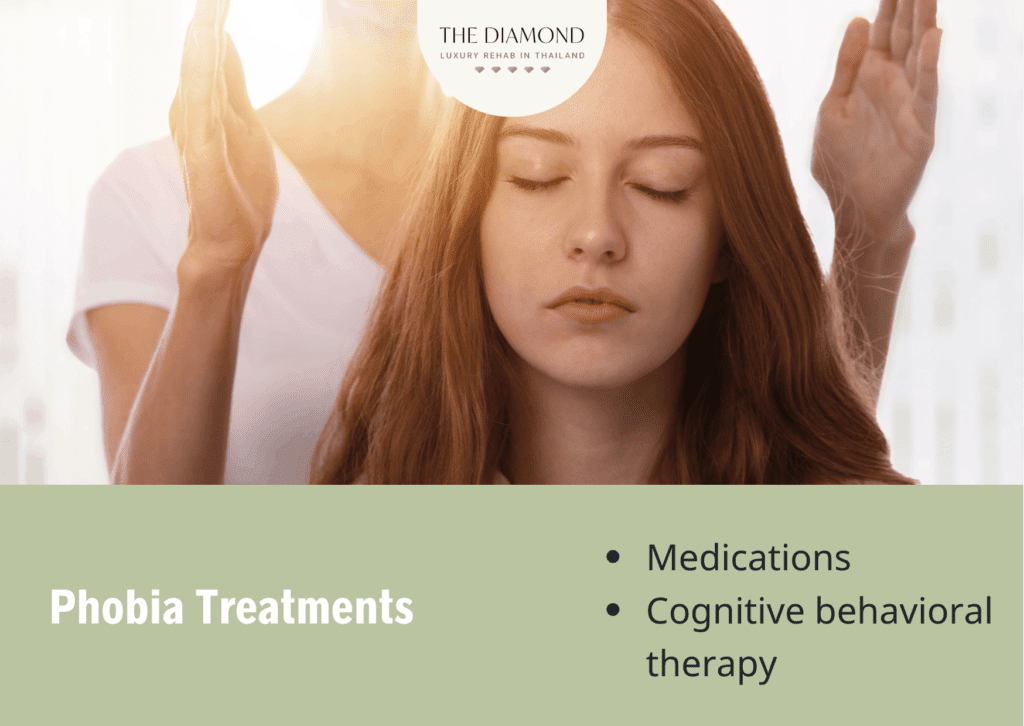Phobia: definition, causes, symptoms, and treatment
Table of content
- What is phobia?
- What are the causes of phobia?
- What are the symptoms of phobia?
- 1. Feeling of uncontrollable anxiety when the source of the fear is present
- 2. Feel that it is imperative to avoid the source of the fear at all costs
- 3. Being unable to perform as intended when exposed to the trigger
- 4. Acknowledgment of the irrationality of the fear and an inability to control the emotions
- What are the common effects of phobia?
- How does a phobia affect the brain’s function?

Phobia is defined as an intense and unexplainable fear of a situation, animal, object, or environment. Being afraid of something doesn’t mean a person has a phobia. As a type of anxiety disorder, phobia tends to be illogical and irrational.
The exact cause of phobia is unclear. Various factors pave the way to the development of a phobia. These include stressful or negative experiences, traumatic events, or having a parent or sibling with a phobia, in which case it’s a learned behavior.
The symptoms of phobia include intense anxiety, shaking, trembling, rapid heart rate, shortness of breath, and a feeling of dread. When exposed to the subject of phobia, a person goes through a wide spectrum of emotions. People usually know their phobia is irrational, but they can’t control their emotions.The most effective treatment approach for phobia is cognitive-behavioral therapy. At times, doctors prescribe medications to treat the effects of phobia, such as severe anxiety. For certain people, a combination of these treatment approaches yield the best effects in the treatment or management of their phobia.
What is phobia?
Phobia is a type of anxiety disorder indicated by exaggerated, inexplicable, and usually illogical or irrational fear of a specific object, situation, or animal.
The term phobia was coined by ancient Greeks. They used the word phobia with a Greek or Latin prefix to refer to different kinds of fear. That practice is still used today, e.g., arachnophobia (fear of spiders) constitutes from the Greek word arakhne, meaning spider, and phobia meaning fear.
While it’s easy to think phobia is a modern-day problem when people are afraid of different things, it has been around for centuries. For example, Hippocrates described social anxiety disorder phobia as shyness back in 400 BC. This category included people who think everyone observes them.
According to a publication titled, “Specific Phobia” set to expire in June 2024 from the National Institute of Mental Health, around 9.1% of Americans, or over 19 million people, have a specific phobia. Several people have more than one phobia, ranging from mild to severe.
Phobia is included in the Diagnostic and Statistical Manual, 5th Edition (DSM-5), published by the American Psychiatric Association. That means there are specific criteria for diagnosis of DSM-5; not everyone is afraid of something that has a phobia. As per the criteria, the duration of phobia symptoms must last for at least six months.
In previous versions of DSM, adult patients with anxiety phobia had to recognize their fear is irrational in order to be diagnosed with this disorder. Children didn’t have to do that. However, DSM-5 changed that criterion. Today, adults aren’t required to acknowledge their fear is out of proportion to reality.
What are the causes of phobia?

Causes of phobia refer to the factors or origins that contribute to the development of phobias, which are intense and irrational fears of specific objects, situations, or activities. The causes of phobia are listed below.
- Stressful experience
- Frightening event
- A family member who a child can “learn” to fear
1. Stressful experience
A stressful experience is a situation or event that elicits a significant level of stress or emotional strain on an individual. It varies widely from person to person, as what is stressful for one individual isn’t the same for another.
Certain phobias are associated with a stressful or negative experience, especially in childhood. Stress produces feelings of depression and anxiety. When not processed or managed adequately, stress decreases one’s ability to cope in specific situations. As a result, a person becomes more anxious or fearful about being exposed to those situations or objects again. Eventually, this leads to a phobia.
A 2014 paper by Polaris Gonzalez and Karen G. Martinez from the Psychiatric Clinics of North America reported that stress increases the likelihood that trauma-related memories will arise in reaction to an actual or potential threat. This leads to PTSD, but certain people potentially react by developing a phobia.
Additionally, the journal Neuropharmacology published a 2014 review by Masneuf et al., that showed that chronic stress raised basolateral amygdala neurons’ glutamatergic activity and excitability, which in turn triggered anxiety-related behaviors.
More precisely, chronic stress causes neuroplasticity changes in the amygdala and other fear network structures, thus predisposing a person to develop chronic anxiety. Since phobia is a form of anxiety disorder, it explains how stressful experiences pave the way to intense fear.
2. Frightening event
A frightening event is any circumstance or incident that makes people feel terrified, afraid, or panicked. This encompasses a wide range of scenarios, from natural disasters and accidents to personal threats or unexpected dangers.
Experiencing a traumatic event is among the most common causes of phobia. Good examples are being trapped in an elevator or being attacked by an animal. These situations have a lasting effect on people. Frightening events lead to a fear reaction that is expressed excessively. It happens due to changes in psychological arousal and reactivity.
For example, being attacked by an animal leaves a person scared of dealing with the same event again. Even months after the attack, they are possibly still frightened or believe it’s going to happen again sooner or later.
That means their fear is excessively emphasized because the structures in the brain change the way they process it. A person keeps focusing on fear and other emotions they feel during a traumatic event. Every time they are exposed to situations that are similar to the frightening event, these emotions reappear even if the event itself is missing.
For instance, the idea of being in an elevator or standing inside it causes symptoms of phobia even if a person isn’t trapped anymore. Or being near the animal causes symptoms of phobia even if the animal isn’t attacking them at the moment and the attack itself happened in the past. A paper by WJ Magee titled, “Effects of negative life experiences on phobia onset from the journal Social Psychiatry and Psychiatric Epidemiology confirmed that the onset of phobia is influenced by unforeseeable and uncontrollable occurrences that pose a threat to an individual or cause physical injury.
3. A family member from whom a child can “learn” to fear
This is the belief that children develop anxieties or phobias by witnessing and copying the emotions of their family members, particularly parents or carers. People often connect this process to the idea of social learning, which says that kids learn how to act and feel, including scary emotions, by watching and copying important people in their surroundings.
In certain situations, a parent or other household member has a phobia that a child “learns” and thereby adopts a fear of something specific too. Although most people don’t think about it this way, a phobia is likely to be a learned response from early life. It develops from factors in the childhood environment. For instance, parents with anxiety or phobia affect how a child copes with stress and anxiety later in life.
Moreover, if parents or siblings have strong reactions to the subject of their phobia, it influences how one feels about a specific situation or thing. So, an individual becomes frightened as well. Eventually, this leads to a phobia. Even though a person’s life isn’t in danger and the subject of phobia didn’t do anything to them specifically, they still develop this anxiety disorder. That’s why phobia isn’t just a reaction to something stressful or frightening; in certain cases, it’s a behavior that people learn.
What are the symptoms of phobia?

Symptoms of phobia refer to the observable and often distressing signs or reactions that individuals with a phobia display when exposed to the object, situation, or activity that triggers their intense and irrational fear. The most common symptoms of phobia are listed below.
- Feeling of uncontrollable anxiety when the source of the fear is present
- Feeling that it is imperative to avoid the source of the fear at all costs
- Being unable to perform as intended when exposed to the trigger
- Acknowledgment of the irrationality of the fear and an inability to control the emotions
1. Feeling of uncontrollable anxiety when the source of the fear is present
Feelings of uncontrollable anxiety when the source of the fear is present refer to the intense and overwhelming anxiety that individuals with a phobia experience when confronted with the source of their phobia. This heightened state of anxiety manifests both physically and psychologically.
Uncontrollable anxiety manifests itself as trembling, sweating, chills or hot flashes, difficulty breathing or shortness of breath, rapid heartbeat, choking sensation, tightness in the chest, and stomach discomfort.
Other symptoms present at this point include headache, dizziness, nausea, dry mouth, pins and needles, confusion, disorientation, and ringing in the ears. The biggest psychological symptom of uncontrollable anxiety is a feeling of dread and fear of dying. A person strongly believes the subject of their phobia is going to put them in great danger. Being exposed to that fear results in symptoms that show the body and mind are in panic mode.
2. Feel that it is imperative to avoid the source of the fear at all costs
Feeling it is imperative to avoid the source of the fear at all costs refers to the strong and compelling belief held by individuals with a phobia that avoiding what triggers their fear is necessary to prevent the onset of intense anxiety or panic.
One of the most prominent signs of phobia is the strong need to avoid the source of phobia no matter what. Avoidance results from a fear of being unable to escape, care for yourself, get help, or deal with anxiety-like symptoms of phobia. Depending on the object of fear, a person feels like something is going to happen to them unless they find a way to avoid it.
For that reason, they strive to avoid places, situations, or even people that are close to their fear in one way or another. For example, a claustrophobic individual avoids places where they need to use elevators. This prevents them from visiting friends and family, or taking job opportunities in tall buildings. Basically, a person organizes their life around phobia. Avoidance is particularly expressed in persons with severe phobias. Results of a 2017 study by Rudaz et al., published in PLOS One showed that extreme avoidance exacerbated the correlation between initial and subsequent levels of general anxiety.
3. Being unable to perform as intended when exposed to the trigger
Being unable to perform as intended when exposed to the trigger refers to those who, when faced with the particular object, circumstance, or activity that sets off their fear, noticeably lose their capacity to carry out duties, activities, or obligations.
Being exposed to the trigger or even worrying about such a scenario takes its toll on performance. That happens due to racing thoughts that prevent a person from focusing on a task at hand. The mind is scattered and chooses to amplify fear-related thoughts that induce anxiety symptoms. Impaired focus and concentration make it difficult for a person to perform their tasks properly. Intense fear reduces problem-solving and decision-making skills, causes memory problems and doesn’t allow a person to process information properly in their mind. For that reason, a phobia interferes with productivity at work or school.
4. Acknowledgment of the irrationality of the fear and an inability to control the emotions
Acknowledging the irrationality of the fear and being unable to control one’s emotions refers to the recognition by individuals with a phobia that their fear is irrational or disproportionate to the actual level of threat posed by the feared object, situation, or activity.
Despite this acknowledgment of irrationality, individuals with a phobia still find it challenging or even impossible to control the intense emotions associated with their fear. In fact, being aware of the irrationality of phobia doesn’t help them overcome their fear. Instead, it makes them feel even worse.
The reason it makes them feel worse is that they become aware of a lack of control over their phobia. Since they know their fear is irrational and can’t do anything about their emotional response, a person feels humiliated and disappointed.
Under normal circumstances, acknowledging the irrationality of fear involves confronting the subject or situation. For a person with a phobia, doing so is impossible without professional help and guidance. That’s why despite understanding the irrational aspect of their fear, a person can’t prevent or stop their reaction and symptoms of anxiety that occur due to exposure to the subject of phobia. They don’t want to deal with symptoms such as shortness of breath and feelings of dread, but they can’t control them.
What are the common effects of phobia?

The common emotional effects of phobia include life-limiting severe anxiety, embarrassment, isolation, helplessness, and loss of control. Phobia additionally contributes to mental disorders and substance use disorders. The latter occurs due to the stress of coping with an intense specific phobia, according to a 2023 article titled, “Specific phobias” from Mayo Clinic.
A person with a phobia usually finds it incredibly difficult to do simple everyday tasks. Phobia affects every aspect of their life including education, social life, and career, depending on the type of fear.
The presence of phobia creates a mental burden where a person keeps wondering why they aren’t like other people. Their fear makes it difficult to have a functioning social circle. As a result, a person with a phobia starts spending less and less time with other people. Since phobia creates uncomfortable situations, it makes a person feel embarrassed. This is particularly the case with social phobia, where the underlying fear is humiliation.One of the worst and most intense effects of phobia is feeling out of control. Despite being aware of the irrational side of fear, a person still realizes they can’t control it. Being aware of a lack of control tends to be overwhelming and further affects the mental health of an individual.
What are the different types of phobia?
The two types of phobia are specific phobia and complex phobia. Their differences and examples are outlined in the table below.
| Type of phobia | Characteristics | Examples |
| Specific phobia | – Formerly called simple phobia – Intense, irrational fear of something that poses little to no actual danger – Even thinking about the object of fear induces anxiety symptoms – Tend to first appear in childhood, around the age of 10, but some people develop specific phobias in adulthood too | There are five different types of specific phobias: – Environment/natural type such as fear of height (acrophobia), darkness (achluophobia), water (aquaphobia/hydrophobia), bacteria (bacteriophobia), thunder and lightning (astraphobia) – Animal type e.g. fear of dogs (cynophobia), rodents (musophobia), reptiles (herpetophobia), insects (insectophobia) etc. – Injury or body-based type including fear of blood (hemophobia), injections (trypanophobia), vomit (emetophobia), medical procedures (iatrophobia), choking (pseudodysphagia), childbirth (tokophobia), etc. – Situational type e.g., fear of tunnels (gephyrophobia), flying (aerophobia), going to the dentist (dentophobia) – Others such as fear of drowning, loud noises |
| Complex Phobia | – More severe, disabling, and disruptive than specific phobias – Associated with deep-rooted fear about a certain circumstance or situation – Tend to develop and adulthood and last for many years – More likely to affect a person’s well-being than specific phobias | The two most common types of complex phobia are: – Social phobia – intense fear in social situations. It completely overwhelms a person and affects their daily life and everyday activities. – Agoraphobia – feeling scared and extremely anxious about being in places or situations that are a) difficult to get out of, b) embarrassing to get out of, and c) might not be able to get help in case of a panic attack. Agoraphobia may include fear of being outside alone, fear of open spaces, being in a crowd, traveling by plane, bus, or car, and being in enclosed spaces such as elevators or a shop. |
How does a phobia affect the brain’s function?

Phobia affects the brain’s function through significant changes in brain activity. Men and women who suffer from phobias display enhanced activity of the amygdala when they are exposed to phobia-producing stimuli.
Amygdala is the brain area that serves as a center for emotional behavior, emotions, and motivation. It participates in decision-making, memory processing, and emotional responses, including anxiety, fear, and aggression.
The right amygdala is linked to negative emotions such as sadness and fear. The left amygdala is more involved in pleasant reactions. The higher the activation of the right amygdala, the more intense the sense of distress caused by phobia disorder.
In an experimental setting, phobia-inducing images increase the activity of the stria terminalis, the anterior cingulate cortex, and the insula. Hyperactivation of these areas of the brain indicates prolonged exposure to phobia-causing stimuli engages more areas of the brain rather than calming them down.
To understand how phobic disorder affects the brain, it’s important to keep in mind that fear creates a distraction. As a result, our focus is on the source of the fear and nothing else. The more intense the fear, so is the focus on it. The human mind becomes preoccupied with that fear, which explains why it’s tricky for a person to calm down.
Even an irrational fear appears realistic at that point. If a person perceives their experience as real, an extreme fear response overcomes the sense of control over the specific situation.
How to tell if someone has a phobia?
The best way to tell if someone has a phobia is to observe how they react to certain objects or situations. A person with a phobia is excessively fearful of something, even if the subject of the phobia doesn’t threaten them in any way. They even go to extra lengths just to avoid that object, environment, or situation. As the subject of phobia gets closer physically or in time, a person with phobia becomes even more overwhelmed and anxious. It’s easy to notice rapid breathing, and at times their hands shake too.
What are the phobia treatments?

Phobia treatments are medications and psychotherapy, such as cognitive-behavioral therapy. Most phobias are curable, NHS UK confirms. However, no single treatment works for different phobias equally. A combination of medications and therapy may be necessary alongside self-help techniques.
1. Medications
Medications for phobia are pharmaceutical interventions designated to assist in the management of phobia symptoms. Frequently prescribed in conjunction with behavioral interventions and therapy, these drugs are components of a comprehensive treatment regimen.
Medications are mainly prescribed to manage the effects of phobias such as anxiety. That means not all patients with phobias need to take medicines. The doctor prescribes medications for the specific needs of patients. Examples of medications that doctors prescribe include antidepressants, beta-blockers, and tranquilizers.
In the treatment of phobia, the main role of medications is to reduce the intensity of emotions a patient is experiencing. For example, beta blockers are usually prescribed for cardiovascular conditions such as high blood pressure, but in this case, they lower anxiety. Beta-blockers decrease the severity of heart palpitations in persons with phobia.Tranquilizers have the same purpose as beta-blockers, but they are mainly prescribed for severe anxiety and at the lowest doses. Antidepressants additionally work to produce calmness and reduce the severity of intense fear and anxiety.
2. Cognitive behavioral therapy
Cognitive-behavioral therapy (CBT) is a type of psychotherapy that focuses on identifying irrational thoughts that lead to negative emotions and behaviors. The therapist then works with the patient to overcome these irrational beliefs and adopt healthier coping mechanisms. Since phobias are irrational, CBT helps.
An important aspect of cognitive behavioral therapy for the treatment of phobia is gradual exposure to fear. That way, a person becomes less anxious about the subject of their phobia. This approach is called desensitization or exposure therapy.
For instance, when a person is afraid of snakes, the therapist starts asking them to read about them. After a while, a therapist shows a picture or a video featuring a snake. As the treatment keeps progressing, the therapist arranges for a patient to visit the local zoo or a reptile house. The final step of exposure therapy in this scenario is holding a snake in a controlled and supervised environment.
Cognitive-behavioral therapy works by allowing patients to gain control over their phobia. A 2015 review by Antonia N. Kaczkurkin and Edna B. Foa from the Dialogues in Clinical Neuroscience confirmed that CBT is effective for the treatment of anxiety disorders.
In phobia treatment, CBT is often structured and time-limited. Certain patients need four to 14 sessions with a therapist, but others need more than that. The number of sessions depends on the severity of the phobia. The therapist determines the most suitable protocol for the specific needs of each patient. The typical length of a session is 30 to 45 minutes, but the initial session lasts up to 60 minutes.
Are phobias considered mental illnesses?
Yes, phobias are considered mental illnesses. As mentioned above, phobia is a form of anxiety, one of the most common mental health disorders. According to a 2022 fact sheet titled, “Mental disorders” from the World Health Organization, a clinically significant disruption in an individual’s behavior, emotion regulation, or thought processes is indicative of a mental disorder.
Mental disorders are linked to distress or impairment in important areas of functioning. Anxiety disorders, such as phobia, are characterized by excessive fear. This explains why phobias are considered mental illnesses. Not every fear is a phobia, though. That’s why not every person with a specific fear automatically has a mental illness. Fear and phobia aren’t synonyms. Fear is a normal reaction to a threat or near/imminent danger, whereas phobia produces a fear response even when a person isn’t in actual danger.

